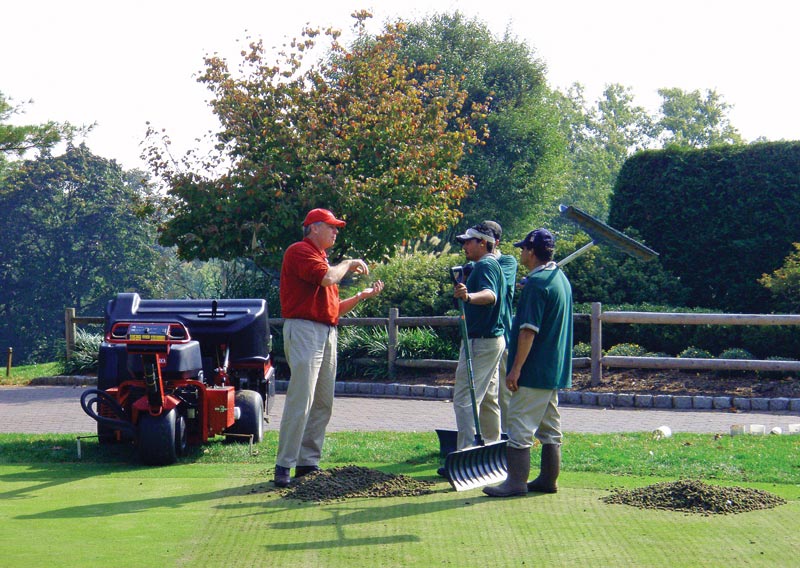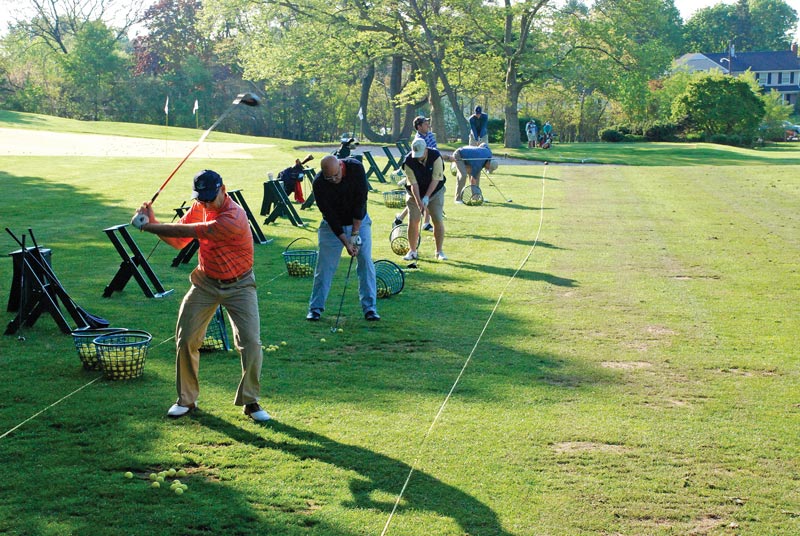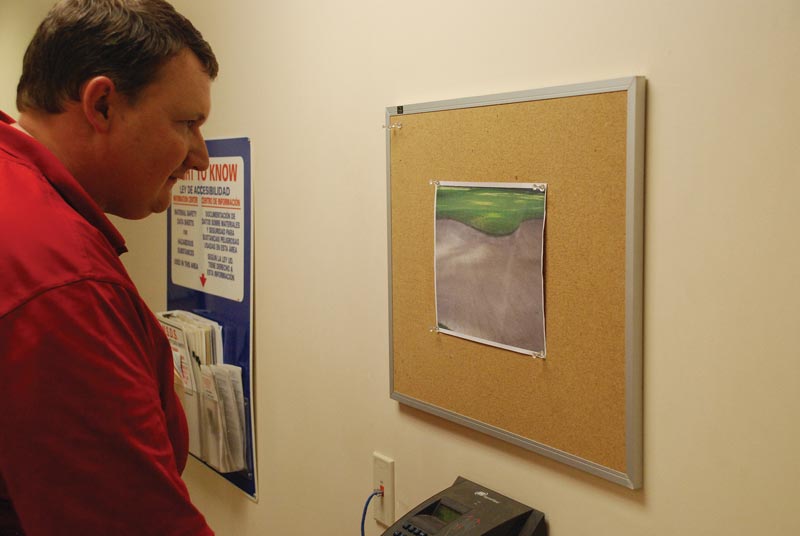
Author Chris Carson (left) explains the importance of aerification to members of his crew at Echo Lake Country Club in Westfield, N.J. Photos courtesy of Chris Carson
The golf professional at my club, a good friend, was giving me a lesson last year. He told me that, like most golfers, when I hit balls on my own, I was doing nothing more than reinforcing the bad points of my swing. He was sincere, but said it with a smile, so I countered with, “Maybe the problem is that you can’t teach!” He volleyed back, “Oh, I can teach. The question is, can you learn?”
I’ve since wondered whether I might ask myself a similar question about how I manage the golf course. Have I done all I can to improve it, or, as with my golf swing, am I just mindlessly beating golf balls? My concern is that, as I’ve come to rely on familiar methods and ideas, I haven’t always had the approach of questioning and improving how I manage.
As I thought about this, I asked myself several hard questions, including, “What does it take to learn?” As a teacher in the Rutgers Professional Golf Turf Management School, it’s a question I ask of my students. I tell them that it takes a positive attitude, a strong desire to constantly improve, being open to new ways of doing things, and always asking why things are being done. More important than these points, though, is a willingness to analyze our professional skills and honestly ask, “How can I improve?”
Every year, as I review how we’re doing on my golf course, I undertake an exercise that has proved extremely useful in challenging myself to stay fresh and current. I evaluate everything we do on the course and try to do three things:
- Change one thing we’ve always done (aerification timing, fertilizer choices, filling gas tanks after use vs. before).
- Add something we’ve never done (fertigation, use of part-time labor, hand-cutting approaches).
- Eliminate something we’ve always done (in-house construction, vacuuming leaves [we mulch them all now], on-site disposal of organic waste).
Of course, I don’t make changes just for the sake of change; there always has to be a sound reason for each decision. Over time, frequent repetition of this exercise has resulted in a more streamlined, efficient operation. It has been a valuable tool in my education and maturation as a superintendent.
With my new goal of remaking my “management swing,” I also took a more drastic step: I fired myself.
Well, not really. But I did ask myself, “If I were the new superintendent at this club, what would I do to establish myself and make the operation better?” The first thing I did was write down everything we do on a sheet of paper and, in columns to the right, grade us on whether the task was essential, whether it was being done well and whether it could be improved. Though I am happy with most of what we’ve accomplished during my 25 years at Echo Lake Country Club, when I took an honest look at what we could be doing, I must admit I believe there is a lot more to achieve.
I’ve made a long list of projects that a new superintendent would do, including rethinking every maintenance procedure, painting the shop, beginning a blog to our members, and clearing out accumulated junk. The most important discoveries I made throughout this process were those concerning service. I’d like to share several ideas that have worked for me, borrowed from a variety of sources. They have helped me get to where I am today, and, I think, will help me reshape where I will be in the future.
Setting expectations on the golf course
Showing usually works better than telling, as the chef at our club, who takes pride in presenting “simple food, prepared well,” certainly understands. He uses photos to emphasize to his staff that presentation is a big part of providing an excellent dining experience. He posts photographs in the kitchen of what each meal should look like.
It’s an uncomplicated method of making sure that plated meals are consistent and to his standards, and it’s an idea that I’ve seen elsewhere too. In the cart barn at Cascata Golf Club in Las Vegas, for example, are photos that show how golf carts should be presented to guests, including proper placement of water bottles, towels and divot mix containers. These photos reinforce the standards of the golf cart operation in a clear way.
I’ve used the idea myself in my maintenance facility by periodically posting a photo at the time clock. Changed frequently, these photos serve as reminders of what we are striving for. For example, I have photos of a properly filled divot, a well-prepared bunker, and, on the negative side, of empty water bottles and cups stuffed into the front of work vehicles. Each photo illustrates a point, either good or bad.
In many ways, this supports a simple concept that I’ve taught at Rutgers: the importance to an operation of a clear and simple mission statement. I must confess, though, that I had not done as good a job as I could have on this point, and I was taught that lesson last year by one of my students. He shared with me a simple mission statement from the course at which he interned, Pebble Beach.
He knew, verbatim, that the facility’s mission is, “To exceed the expectations of every guest by providing a once-in-a-lifetime experience, every time.” When I asked him why he could recite that statement so clearly, he shared with the class that Pebble Beach Resorts made it almost impossible for him not to know the company’s mission. They constantly reinforce that clear and simple statement. They’ve done a great job of making sure that all of their employees know the goal, and know that attaining this goal should shape how they do their jobs.
I’ve thought about Pebble Beach’s mission statement often over the past year. I was convinced that a similar statement would help my own operation. Thus, with the help and guidance of my green committee, we now have a clear written statement of what we wish to achieve.

Like the golfer who is just “beating balls” while on the practice tee, a superintendent can develop a habit of ignoring — or even reinforcing — a bad “management swing.”
Two companies that supply my club are known for their remarkable level of service. The owner of one, a tree management company, has told me, “We can out-service anybody else in the business.” When I asked him what he meant by that, his response was surprisingly simple. He makes sure that the phone is answered, that his crews do what they say they are going to do when they said they are going to do it, and that his company does a better job than the client expects.
The other company is a material supply company that provides technical advice, finds obscure items and delivers products with incredible speed. The staff of this company is set up to respond quickly, and rarely will an emergency need not be fulfilled within two hours — even when the call is made at 6 a.m. on a Saturday. The owner of this company has set his company up with service in mind and has stated, “We all carry similar products. What sets us apart is our ability to get them to you when you need them.”
I’ve learned a comparable lesson from the head professional at my club (yes, the same guy who thinks there’s room for improvement in my golf swing). He has a two-page document that he asks every new employee in his operation to study. It discusses how to dress, act and interact with members, and lays out some basic principles of how he wants his golf operation to function. Emphasizing the importance of member relations, this document sets clear standards on how the professional staff should operate.
The closing statement of his paper is one that elegantly summarizes the service aspect of the golf business: “Members and their guests are not an interruption of our business; they are our business.”
I am certain that if I can convince my own staff of this simple principle, they will be more aware of our most important goal: providing customer satisfaction. For example, we all know that it can be frustrating to have to “work around” golfers, but if we remember that these same golfers are the reason we are employed, then our mindset becomes more service-oriented and member-friendly.
On working together
GCSAA offers another example of how this reinvention concept can work. Over the past several years our governing body has been forced by economic circumstances to review and refine what we are and what we want to be. During strategic planning meetings, our leaders have considered how they can balance the needs of the association with those of the membership. By answering honestly, they’ve taken a number of painful but necessary steps to ensure our continued strength and viability. That they’ve kept us well informed along the way illustrates also that they view membership communication and transparency of governance as two of their most important aims.
As I see it, GCSAA has gone back toward our core mission of supporting the golf course superintendent through education and outreach, and I believe that most of my fellow members agree that this has been appropriate. As they’ve undertaken those sometimes painful steps toward that end, they’ve communicated both the need for those steps and their sincere regret for the human toll on headquarters staff that was necessitated. I believe that, in the process, GCSAA has strengthened the support it receives from its membership. We know those steps were necessary, and we are generally thankful that our leadership didn’t avoid them.
The strength of our association lies in collaboration, which means more than good employee relations, or even the interaction between our headquarters staff and board of directors. I’m certain that our success comes from the understanding, support and contributions of every GCSAA member. Though there will always be issues that concern various factions of our membership, my take as a rank-and-file member is that this support does exist and that our members want our association to thrive. As our board continues to clarify our new reality in tough economic times, it seems obvious that their work will be more effective if our membership buys into GCSAA’s mission and goals.
The best golf operations have a similar feeling of partnership, of everybody working together for the common good, and this concept works elsewhere as well. One of the best examples I’ve seen was in a documentary that discussed how a large cruise ship turns over a shipload of passengers in a 12-hour window. Thousands of employees worked rapidly and resourcefully to clear the boat of passengers, luggage and waste, and then loaded the boat with 6,000 people along with massive amounts of food and material.
What I found most remarkable, and what I think is the take-home message from this program, was that every one of the employees interviewed, from the people who handled the arrival of guests to the maids who cleaned to the food handlers who prepared the meals, all said a version of the same thing: “What I do is important. Without my operation, this ship doesn’t sail and our guests don’t have an exceptional experience.”

A course photo posted near the time clock in the Echo Lake Country Club maintenance facility is a visual reminder to staff of the club’s expectations for playing conditions.
It’s a lesson that was reinforced to me at the retirement of a longtime employee of my club. John Famula was a caretaker of our ornamental beds and flowers. He was hired at age 65 and worked until age 78. When he finally left us, I presented him with a framed photograph of our club and thanked him for his dedication and hard work. He said a few words to our crew, and, in his humble way, he expressed with remarkable clarity the management philosophy that I’ve since fully embraced. He told our crew that they should continue to take pride in their work, and to “never forget that what you do is important.”
Now that I’ve “fired” myself, reworked my “management swing” and rehired a reinvigorated me, I’ve found that those simple words contain an important message. If we can have our employees embrace the mission and goals of our club, and if we can have them feel good about their role in what they do, we can achieve great things.
If you’ve been at your club for a while, why not think about what you would do at your club if you were the brand-new superintendent walking in the door the first day. You just might find that an adjustment to your “management swing” will help your operation too.
Chris Carson is the GCSAA Class A superintendent at Echo Lake Country Club in Westfield, N.J., and a 25-year member of the association.